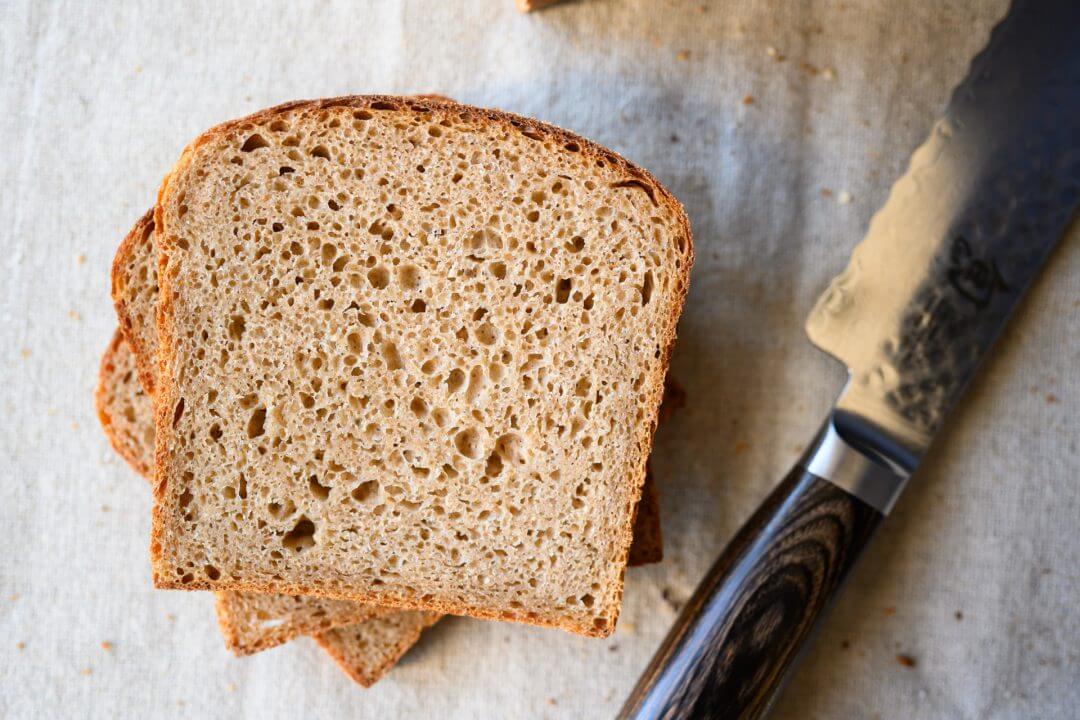Spelt found its way into my baking rotation ages ago and has since become a regular in many of my recipes. It has an unmistakable flavor that permeates and pervades a loaf of bread, much like warming butter on the stove seems to occupy a house all at once. And while I’ve been keen on the nutritious grain for years, I’ve never ventured down the path of a 100% whole grain spelt pan loaf. Let’s change that.
Keeping with my recent predisposition towards baking in pans—see my recent pain de mie and my barley pan loaf—I just knew spelt would lend itself nicely to the confines of a rectangular pan, especially since I like to push pan loaves to high hydration. So my first trials with this recipe were structured around increasing the water at each attempt, but after several iterations, I found myself preferring previous results with lower hydrations: more doesn’t always mean better.
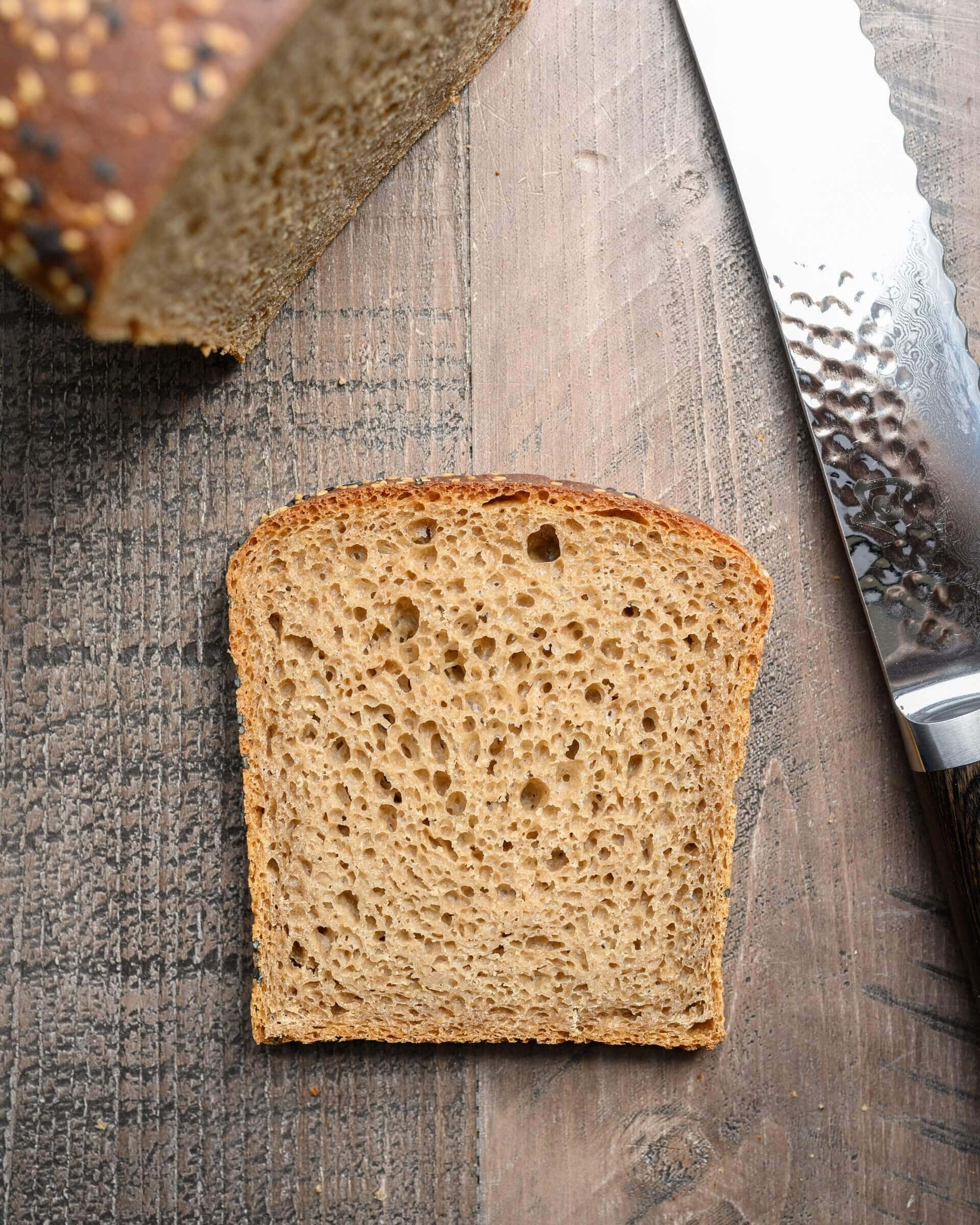
As you can see in the image above, the interior on this loaf with hydration at 80% resulted in a crumb that was very tender and custard-like. While this is typically what I’m after with a hearth loaf, I found the texture to be a little off even if the flavor was quite good. In later tests, I reduced the hydration down from 80% to 75% (stopping at each digit along the way), finally achieving a loaf that was fluffier, lighter, and more delicate—just the result I had envisioned. The difference in results is subtle but noticeable.
As always, be sure to adjust the hydration of this recipe to suit your flour, starting low and working up.
Fiddling with the hydration in any recipe is always a back-and-forth play. There’s a fine line between just hydrated enough, and gone too far. And while this recipe clocks in at 75% hydration, keep in mind there is also honey and olive oil added to the dough, two more forms of liquid. Be sure to adjust the hydration of this recipe to suit your flour, perhaps starting at 70% hydration if you’re working with new flour.
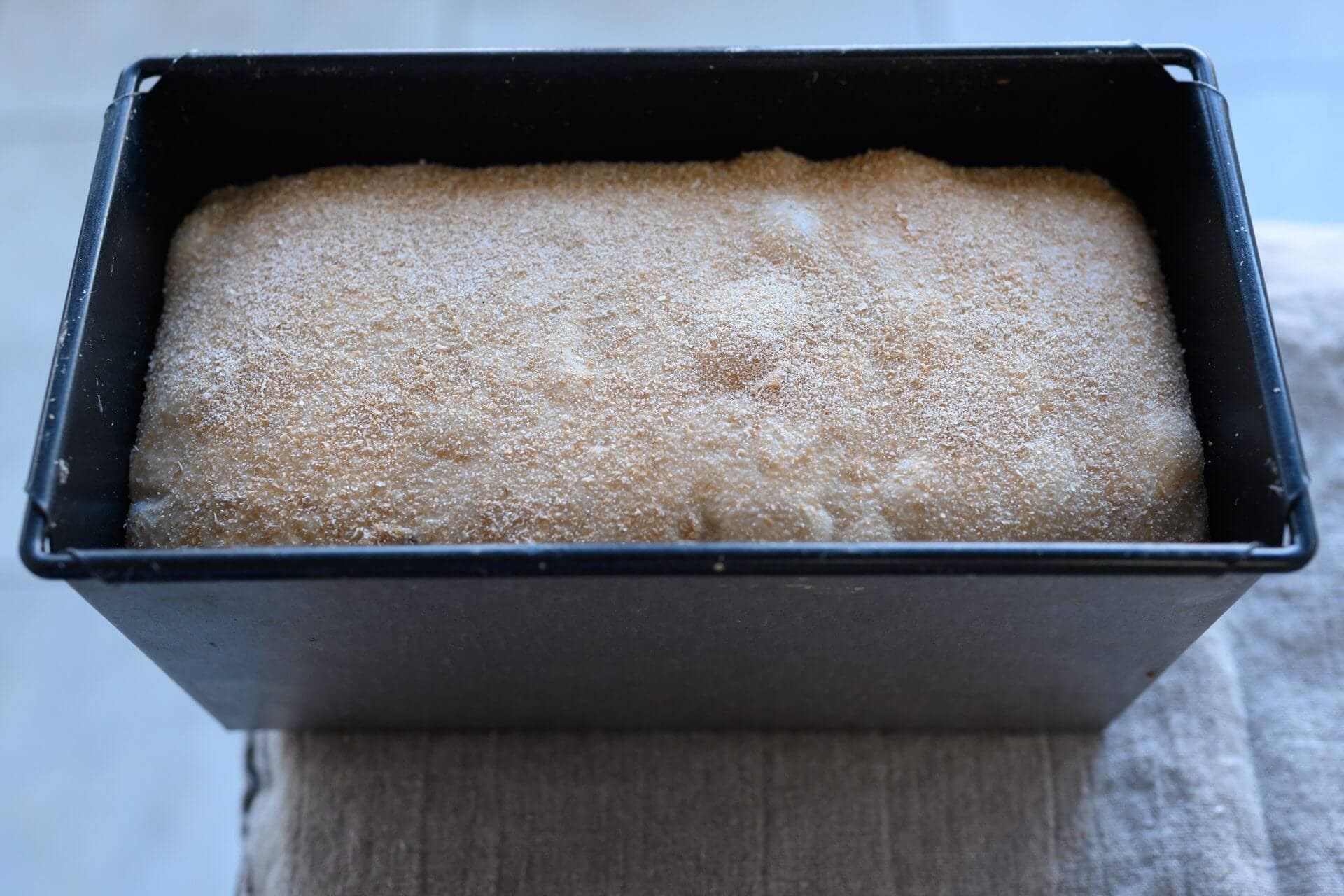
So why 100% spelt flour? A recipe such as this has been mulling around in my head for a while, but additional motivation came in the form of several emails I received on the nutritional benefits of spelt flour when used in a whole grain sourdough bread.
Spelt and a Low FODMAP Diet
Certain foods high in FODMAPs (fermentable oligosaccharides, disaccharides, monosaccharides, and polyols), which are carbohydrates, can be responsible for discomfort in those who have trouble digesting/absorbing them in their small intestine, particularly those who have IBS or other gastrointestinal disorders. While I don’t personally have IBS or suffer from a food-based allergy or illness, I can sympathize with those in that situation.
Traditional sourdough bread made with whole grain spelt flour can classify as a low FODMAP food, conforming to the diet. This isn’t to say spelt itself is low FODMAP, but when the grain is used in a traditional sourdough bread (with is lengthy natural fermentation), it is better tolerated. This is promising for those who strictly adhere to a low FODMAP diet, potentially allowing them to eat bread—something on the do-not-eat list—in moderation.
And in addition, spelt has higher levels of protein than modern wheat, is a good source of dietary fiber, vitamins, and minerals. Plus, it just tastes great—when you take a bit of this bread your body just knows it’s healthy.
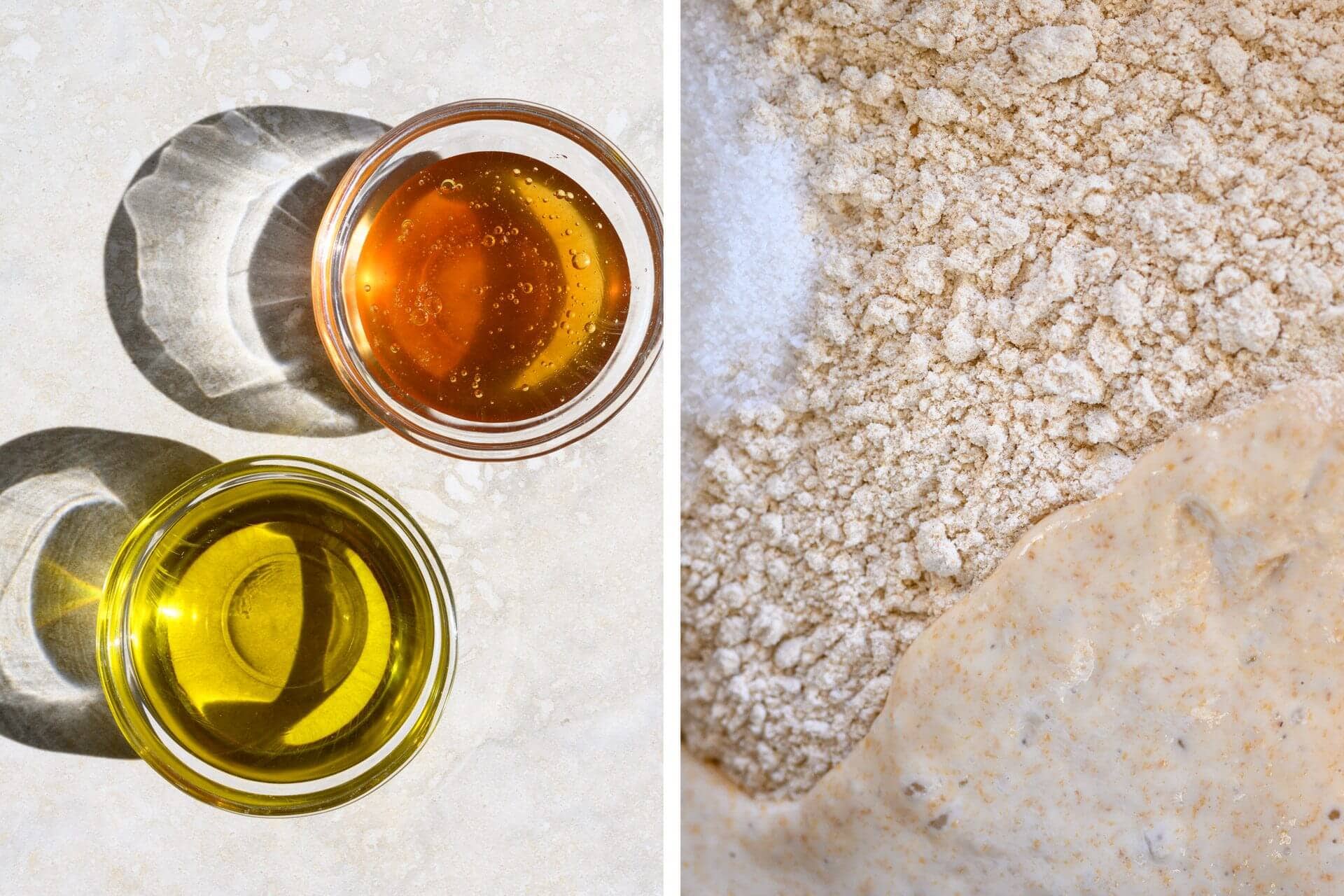
Whole Grain Spelt Pan Loaf Recipe
The quantity of extra virgin olive oil and honey in this recipe is right in balance: you will taste a hint of sweetness from the honey and a slightly fruity flavor and a soft texture from the olive oil. I toyed with lower percentages of each (little impact) and higher percentages (too overpowering) and settled on just the right amount. Additionally, I increased the salt percentage from my typical flat 2% to 2.2% to help draw out more of the whole grain flavor.
Note that honey is not a low FODMAP food, but the honey used in this recipe can easily be replaced, 1-for-1, by pure maple syrup.
Depending on the size of your baking pan, you might need to adjust the total weight of this dough, or split it into two loaves. See my guide to shaping a pan loaf for various pan sizes and dough weights.
I used my 8.85″ x 4.7″ x 4.7″ bread pan for this bake.
Vitals
| Total Dough Weight | 1,400 grams |
| Pre-fermented Flour | 5.50% |
| Hydration | 75% |
| Yield | One 1,400 g pan loaf |
Total Formula
| Weight | Ingredient | Baker’s Percentage |
|---|---|---|
| 745g | Whole grain spelt flour (Central Milling Whole Spelt Flour) | 100.00% |
| 558g | Water | 75.00% |
| 37g | Honey (substitute for pure maple syrup for a low FODMAP option) | 5.00% |
| 37g | Extra virgin olive oil | 5.00% |
| 16g | Salt | 2.20% |
| 6g | Sourdough starter (100% hydration) | 0.83% |
Levain Build
Note that only a small amount of sourdough starter is needed for this recipe. Overnight, this small bit of starter, fresh flour, and water, grows to an 80g levain mixed into the final dough. See my guide to the differences between a levain and sourdough starter for more information.
| Weight | Ingredient | Baker’s Percentage |
|---|---|---|
| 6g | Ripe sourdough starter (100% hydration) | 15.00% |
| 41g | Whole grain spelt flour (Central Milling Whole Spelt Flour) | 100.00% |
| 41g | Water | 100.00% |
Dough Formula
The target final dough temperature (FDT) is 78°F (25°C).
Note that the baker’s percentages listed below are with respect to the final dough ingredients and do not take into account the levain.
| Weight | Ingredient |
|---|---|
| 704g | Whole grain spelt flour (Central Milling Whole Spelt Flour) |
| 518g | Water |
| 37g | Honey (substitute for pure maple syrup for a low FODMAP option) |
| 37g | Extra virgin olive oil |
| 16g | Salt |
| 88g | Ripe liquid levain (see above) |
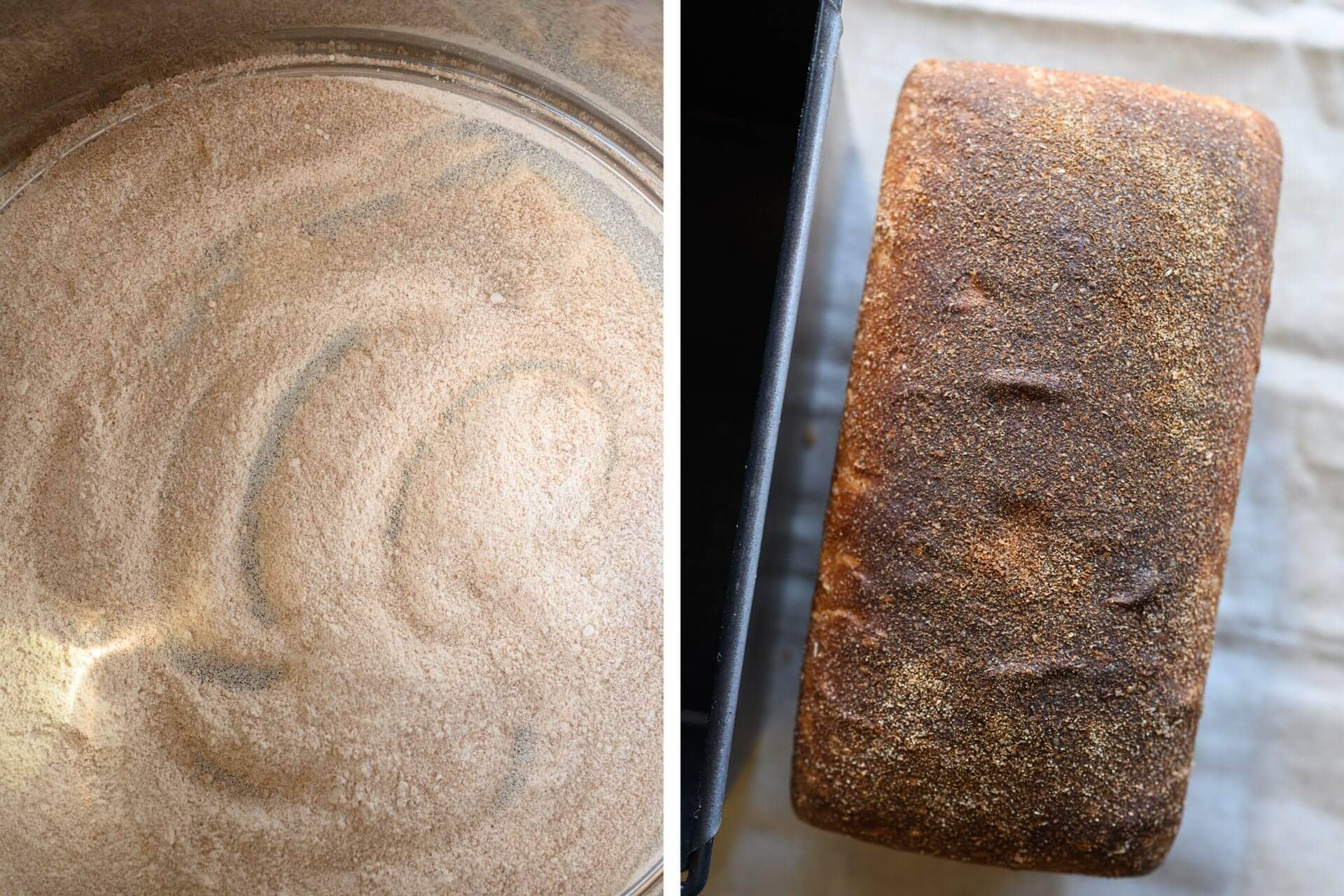
Method
1. Liquid Levain – Night before mixing, 9:00 p.m.
Add the called for mature sourdough starter, water, and flour listed in the Levain Build section above to a clean jar. Mix well and cover overnight.
2. Mix – 9:00 a.m.
When your levain is mature and ready to be used, add the flour, levain, honey, extra virgin olive oil, salt, and water to a mixing bowl. Usually, I hold back enrichments (EVOO, honey) from a dough until after strengthening (read why, here), but this dough came together without issue when everything was added at the onset. Using your hands, mix everything until it comes together into a shaggy mass. Continue to stretch and fold the dough over itself in the bowl to build strength, it will transform from sticky and shaggy to smooth and elastic over the course of 4-5 minutes.
Transfer the dough to a container for bulk fermentation and cover.
3. Bulk Fermentation – 9:15 a.m. to 12:45 p.m.
During the three and a half hour bulk fermentation, give the dough four sets of stretch and folds. The first set will be 15 minutes after the start of bulk fermentation, then every 30 minutes thereafter. Let the dough rest after the last set of stretch and folds for the remainder of bulk fermentation.
4. Preshape – 12:45 p.m.

I find it easier to preshape this dough using water on the bench and hand instead of flour. Fill a bowl with a little water and place it near your work surface. Gently scrape out your dough from the bulk container onto your dry counter. Using a wet hand and bench knife, preshape the amorphous blob into a very taut round.
Be sure to preshape this dough rather tight to give it extra strength and to prevent excessive spreading on the counter.

Let the dough rest, uncovered, for 20 minutes.
5. Shape – 1:05 p.m.
If your baking pan is not non-stick, lightly grease the interior of the pan with oil.
Depending on how slack your dough is, this can be a slightly challenging dough to shape. Liberally flour your work surface and the top of the preshaped round with whole-grain spelt flour, and shape quickly, tightly, and confidently.
I shaped this dough following my guide to shaping pan loaves.
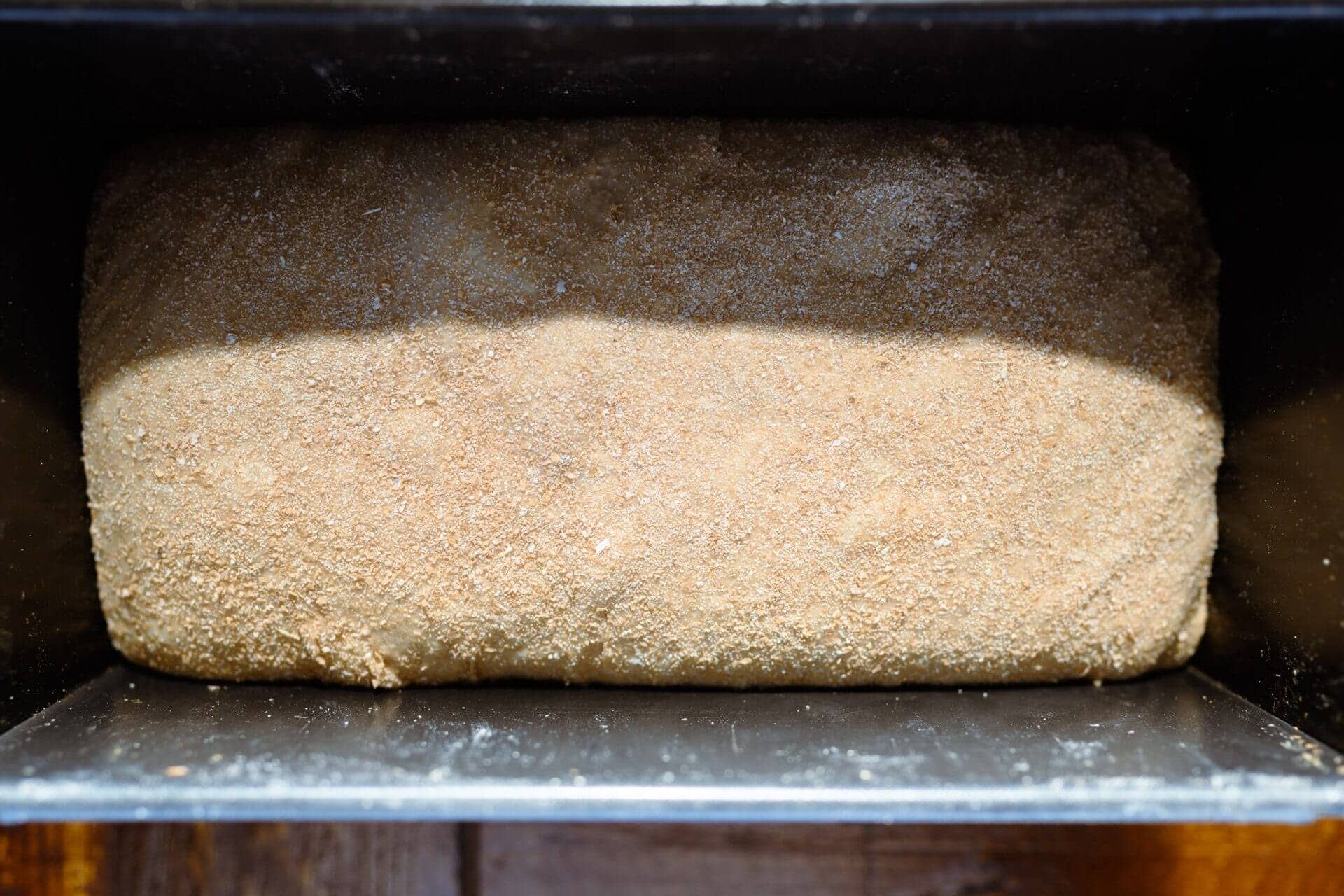
As you can see above, I milled some fresh spelt flour and sifted out the large bran pieces to use a topper to this dough after shaping. Not only does this added bran give the loaf extra texture, but it also brings extra nutrition. Feel free to use instant/rolled oats (as I often do), seeds, or simply use nothing.
After shaping your dough tightly, quickly roll the smooth (top) side on a pile of the sifted bran resting on a towel, then place the shaped dough in the pan.
6. Proof – 1:15 p.m. to 2:45 p.m. (or until ready)
Cover the pan with a reusable plastic bag and proof for 1-2 hours, temperature depending. For me, at my kitchen temperature of 76°F (24°C), it took one and a half hours for this dough to fully proof.
Give the dough a poke periodically with a wet finger. This dough should pass the “poke test” when it’s ready to bake: a firm poke should show an impression in the dough that springs back very slowly, perhaps not quite filling the indentation.
7. Bake – 2:45 p.m. (pre-heat oven at 2:15 p.m.)
Preheat your empty oven (there’s no need for a baking stone for this bread) to 450°F (230°C).
I used my typical oven-steaming method for this loaf but did not use the pan with lava rocks. I boiled water and poured it over rolled-up towels in a pan and placed the pan at the bottom of my oven before loading the dough. Additionally, I sprayed the top of the dough with a handheld mister a few times after loading it into the oven.
When your dough is fully proofed, place the steaming pan into the oven and your dough pan on a rack above. Spray several times into the oven chamber with a handheld spray bottle and close the oven door.
Drop the oven temp to 425°F (218°C) and bake for 20 minutes with steam. After 20 minutes, remove the steaming pan and bake for an additional 25-30 minutes at 425°F (218°C). After that, when the dough looks well colored on top and the interior temp registers around 205°F (96°C), remove the loaf from its pan and finish baking in the oven directly on the oven rack for 5 minutes for more color.
Finally, remove the loaf from the oven and let it cool on a wire rack for at least 3-4 hours before slicing.
Conclusion
This whole grain spelt pan loaf with honey and olive oil fills the kitchen with the deepest, richest aroma as it bakes. The aroma lingers hours after baking as its diffusive aroma pulls you ever closer, like sirens from an island. And in much the same way, there’s little you can do on approach, you’ll just have to have a slice—maybe two.
Further, a good slather of salted butter seems to draw out more nuance, melding with the fruity olive oil and sweet honey in a concert of mouth-watering flavor. I think this bread might be one of the most versatile and flavorful whole grain sourdough recipes I’ve ever baked.
Crust
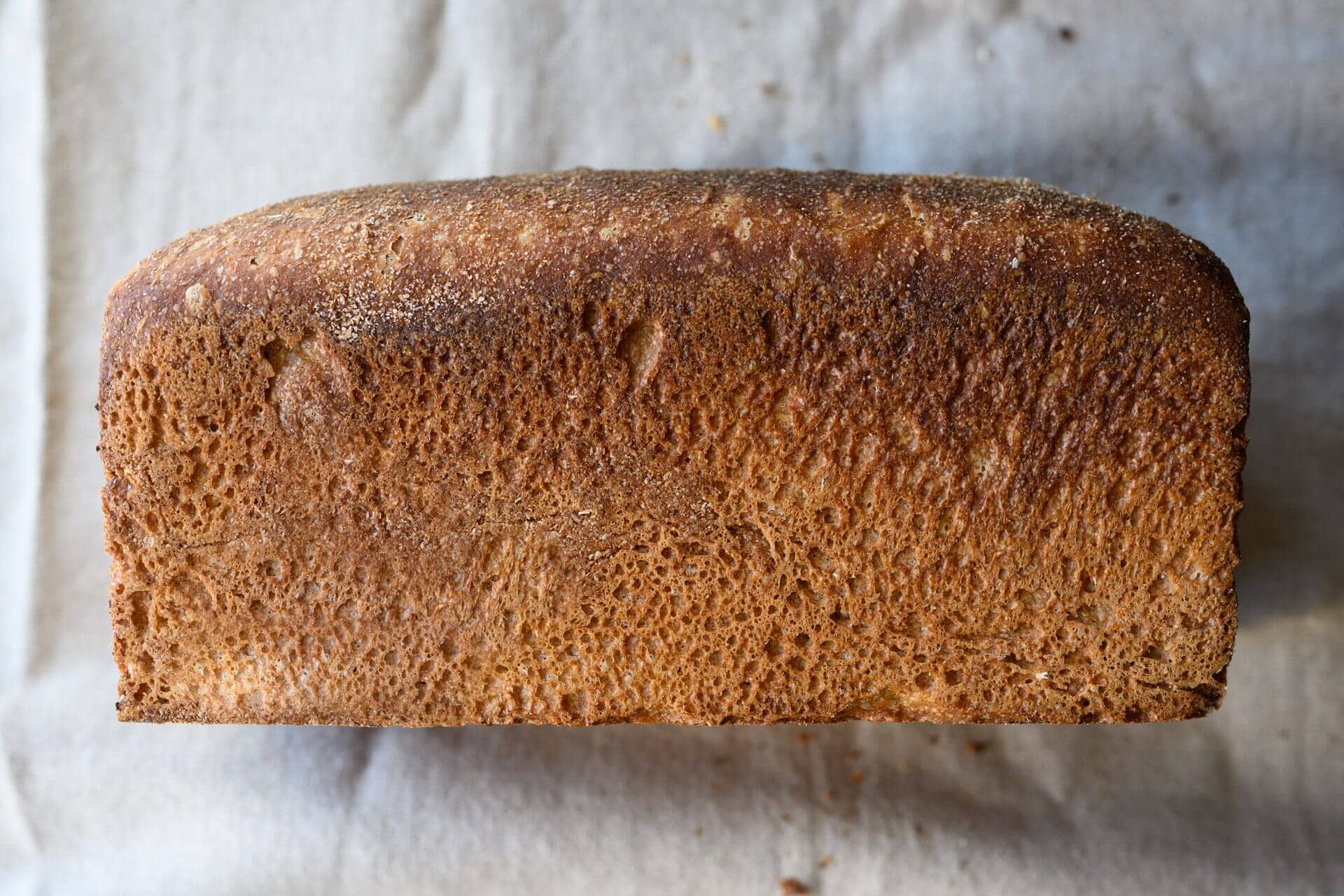
The crust bakes up golden brown, is beautifully thin (especially for a 100% whole grain bread), and brings forth just a hint of honey. As usual, I’ve been milling lots of fresh flour here in my kitchen and sifting off some of the bran to use as a topper was a useful way to add texture and nutrition to this pan loaf.
Crumb

The crumb is superbly light and fluffy, soft and pliant. However, uncut the loaf feels rather heavy in hand but slicing in reveals the truth: each slice is airy and just-tight-enough for toast and sandwiches.
The extra virgin olive oil helps bring a measure of softness to the crumb, and at 5%, it is just right—any more might be too soft.
Taste
The slight fruitiness from the olive oil pairs well with the sweetness from the honey—but more than this, the spelt itself brings so much flavor this bread is a smash hit here in my house. When your family gets close to devouring a 1400g loaf in two days, you know you’re on to something.
I think this bread might be my new favorite whole grain pan loaf. There, I said it. Buon appetito!
Print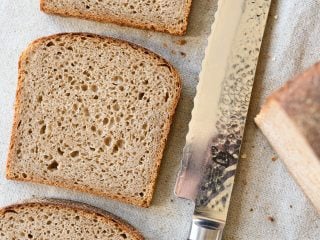
Whole Grain Spelt Pan Loaf
- Author: Maurizio Leo
- Prep Time: 24 hours
- Cook Time: 55 minutes
- Total Time: 24 hours 55 minutes
- Yield: One 1400g pan loaf
Description
A deeply flavorful whole grain spelt pan loaf with a touch of honey for sweetness.
Ingredients
Levain
- 6g ripe sourdough starter
- 41g whole grain spelt flour
- 41g water
Main Dough
- 704g whole grain spelt flour
- 518g water
- 37g honey
- 37g olive oil
- 16g salt
- 88g ripe levain (above)
Optional
- Coarse wheat bran or rolled oats for topping
Instructions
- Levain (Night before 9:00 p.m.)
Add the levain ingredients to a jar and mix well. Leave to ferment overnight. - Mix (9:00 a.m.)
When your levain is mature and ready to be used, add the Main Dough ingredients and the levain (from step 1) to a mixing bowl. Using your hands, mix everything until it comes together into a shaggy mass. Continue to stretch and fold the dough over itself in the bowl to build strength, it will transform from sticky and shaggy to smooth and elastic over the course of 4-5 minutes. Transfer the dough to a container for bulk fermentation and cover. - Bulk fermentation (9:15 a.m. to 12:45 p.m.)
During the 3.5 hour bulk fermentation, give the dough four sets of stretch and folds where the first set is 15 minutes after the start, then every 30 minutes thereafter. After the fourth set, let the dough rest, covered, until the end of bulk. - Preshape (12:45 p.m.)
Gently scrape the dough out of the bulk fermentation container to an unfloured work surface and preshape tightly into a taut round. Let the dough rest, uncovered, for 20 minutes. - Shape (1:05 p.m.)
Shape the dough into a long tube and place in the loaf pan. Top with coarse bran or rolled oats, if desired. - Proof (1:15 p.m. to 2:45 p.m., or until ready)
Cover the pan with reusable plastic and proof on the counter for 1-2 hours until the dough is very soft to the touch. - Bake (2:45 p.m.)
Preheat empty oven to 450°F (230°C). Drop the oven temp to 425°F (218°C) and bake for 20 minutes with steam. After 20 minutes, remove the steaming pan and bake for an additional 25-30 minutes at 425°F (218°C). After that, when the dough looks well colored on top and the interior temp registers around 205°F (96°C), remove the loaf from its pan and finish baking in the oven directly on the oven rack for 5 minutes for more color. Finally, remove the loaf from the oven and let it cool on a wire rack for at least 3-4 hours before slicing.
Notes
- For a low FODMAP option, substitute out the honey for pure maple syrup.


